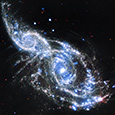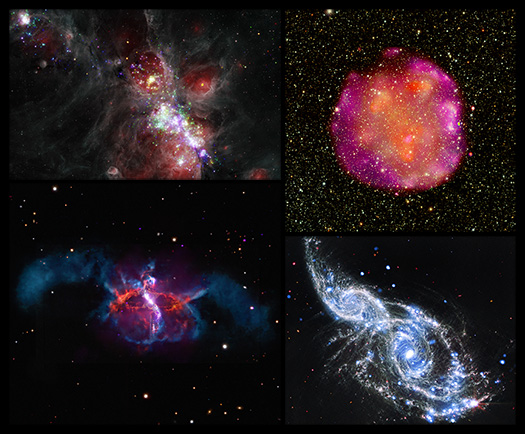Fall Collection: Before Fall Leaves, See Seasonal Offerings from NASA's Chandra
Before fall gives way to winter in the northern hemisphere, NASA’s Chandra X-ray Observatory has several images that celebrate autumn and its many delights to share. In spirit of the season, this collection gathers Chandra data with those from its telescopic family including NASA’s James Webb, Hubble, and Spitzer Space Telescopes, plus others in space and on the ground.
Here is a sample of the seasonal offerings that space has in store:
NGC 6334: COSMIC LEAVES BLOWING
 For many, nothing evokes fall more than fallen leaves. In this view of NGC 6334, glowing pockets of dust and gas in the nebula resemble leaves that have been picked up by a wind gust. This region is actually home to strong winds blowing from the young stars that have formed there. This image contains X-ray data from Chandra (blue, green, and yellow) that shows the effects of these winds, which have been combined with infrared data from the now-retired Spitzer Space Telescope (red, brown), which shows the dust and gas that fuels the growing stars.
For many, nothing evokes fall more than fallen leaves. In this view of NGC 6334, glowing pockets of dust and gas in the nebula resemble leaves that have been picked up by a wind gust. This region is actually home to strong winds blowing from the young stars that have formed there. This image contains X-ray data from Chandra (blue, green, and yellow) that shows the effects of these winds, which have been combined with infrared data from the now-retired Spitzer Space Telescope (red, brown), which shows the dust and gas that fuels the growing stars.
G272: THE SPACE PUMPKIN
 Born after a violent explosion of a star, this cosmic gourd is the supernova remnant G272.2-03.2. X-ray observations (orange and magenta) from Chandra provide evidence that G272 is the result of a Type Ia supernova explosion, where a white dwarf star pulls material from a companion star until it triggers a thermonuclear explosion and obliterates the star. The inside of the “pumpkin” is superheated gas that is filling the space cleared out by the explosion as it moves outward.
Born after a violent explosion of a star, this cosmic gourd is the supernova remnant G272.2-03.2. X-ray observations (orange and magenta) from Chandra provide evidence that G272 is the result of a Type Ia supernova explosion, where a white dwarf star pulls material from a companion star until it triggers a thermonuclear explosion and obliterates the star. The inside of the “pumpkin” is superheated gas that is filling the space cleared out by the explosion as it moves outward.
R AQUARII: A COSMIC SWEATER
 Multiple telescopes teamed up to capture an image that looks like a cozy sweater with fuzzy arms. X-rays from Chandra and ESA’s XMM-Newton (purple), optical light data from Hubble and the Very Large Telescope in Chile (orange, red, and violet), and an optical image from astrophotographer Bob Fera (deep blue) combine to reveal R Aquarii. Nestled within the cozy ‘body’ of R Aquarii is a pair of stars where a white dwarf is pulling material from a much larger red giant companion. When enough material accumulates on the surface of the white dwarf, it triggers an outburst that sends a jet out into space. Over time, these jets twist and loop around each other weaving the structure seen today.
Multiple telescopes teamed up to capture an image that looks like a cozy sweater with fuzzy arms. X-rays from Chandra and ESA’s XMM-Newton (purple), optical light data from Hubble and the Very Large Telescope in Chile (orange, red, and violet), and an optical image from astrophotographer Bob Fera (deep blue) combine to reveal R Aquarii. Nestled within the cozy ‘body’ of R Aquarii is a pair of stars where a white dwarf is pulling material from a much larger red giant companion. When enough material accumulates on the surface of the white dwarf, it triggers an outburst that sends a jet out into space. Over time, these jets twist and loop around each other weaving the structure seen today.
NGC 2207 and IC 2163: A PAIR OF GALACTIC CORNUCOPIA
 A cornucopia is a horn-shaped basket that traditionally carries fruits and vegetables. There is nothing edible in this pair of galactic cornucopias but there are a bounty of stars, dust, and other ingredients than make up these two spiral galaxies, known as NGC 2207 (right) and IC 2163 (left), that we see face-on. This view of NGC 2207 and IC 2163 takes a James Webb infrared image (white, gray, and red) and adds the X-ray view from Chandra (blue). Together, it is quite an eye-catching result.
A cornucopia is a horn-shaped basket that traditionally carries fruits and vegetables. There is nothing edible in this pair of galactic cornucopias but there are a bounty of stars, dust, and other ingredients than make up these two spiral galaxies, known as NGC 2207 (right) and IC 2163 (left), that we see face-on. This view of NGC 2207 and IC 2163 takes a James Webb infrared image (white, gray, and red) and adds the X-ray view from Chandra (blue). Together, it is quite an eye-catching result.

